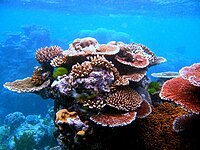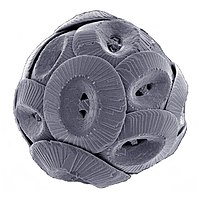
Ocean acidification effects on calcification and dissolution in tropical reef macroalgae
Sign Up to like & getrecommendations! Published in 2020 at "Coral Reefs"
DOI: 10.1007/s00338-020-01991-x
Abstract: Net calcification rates for coral reef and other calcifiers have been shown to decline as ocean acidification (OA) occurs. However, the role of calcium carbonate dissolution in lowering net calcification rates is unclear. The objective of… read more here.
Keywords: macroalgae; net calcification; calcification rates; calcification ... See more keywords

Irradiance, photosynthesis and elevated pCO2 effects on net calcification in tropical reef macroalgae
Sign Up to like & getrecommendations! Published in 2021 at "Journal of Experimental Marine Biology and Ecology"
DOI: 10.1016/j.jembe.2020.151489
Abstract: Abstract Calcifying tropical macroalgae produce sediment, build three-dimensional habitats, and provide substrate for invertebrate larvae on reefs. Thus, lower calcification rates under declining pH and increasing ocean pCO2, or ocean acidification, is a concern. In… read more here.
Keywords: macroalgae; elevated pco2; net calcification; calcification rates ... See more keywords

High calcification rates and inferred metabolic trade-offs in the largest turritellid gastropod, Turritella abrupta (Neogene)
Sign Up to like & getrecommendations! Published in 2020 at "Palaeogeography, Palaeoclimatology, Palaeoecology"
DOI: 10.1016/j.palaeo.2020.109623
Abstract: Abstract Turritella abrupta (Miocene-Pliocene) is the largest species known from the diverse Jurassic-Recent gastropod family Turritellidae. In addition to having achieved long length and substantial width, the species produces shells of exceptional thickness, even before… read more here.
Keywords: high calcification; turritella abrupta; calcification rates; turritella ... See more keywords

pH Variability Exacerbates Effects of Ocean Acidification on a Caribbean Crustose Coralline Alga
Sign Up to like & getrecommendations! Published in 2019 at "Frontiers in Marine Science"
DOI: 10.3389/fmars.2019.00150
Abstract: Crustose coralline algae (CCA) are among the most sensitive marine taxa to the pH changes predicted with ocean acidification (OA). However, many CCA exist in habitats where diel cycles in pH can surpass near-future OA… read more here.
Keywords: treatment; calcification rates; ocean acidification; calcification ... See more keywords

Intercomparison of four methods to estimate coral calcification under various environmental conditions
Sign Up to like & getrecommendations! Published in 2020 at "Biogeosciences"
DOI: 10.5194/bg-17-887-2020
Abstract: Abstract. Coral reefs are constructed by calcifiers that precipitate calcium carbonate to build their shells or skeletons through the process of calcification. Accurately assessing coral calcification rates is crucial to determine the health of these… read more here.
Keywords: calcification rates; coral calcification; environmental conditions; incorporation ... See more keywords

A global compilation of coccolithophore calcification rates
Sign Up to like & getrecommendations! Published in 2018 at "Earth System Science Data"
DOI: 10.5194/essd-10-1859-2018
Abstract: Abstract. The biological production of calcium carbonate (CaCO3), a process termed calcification, is a key term in the marine carbon cycle. A major planktonic group responsible for such pelagic CaCO3 production (CP) is the coccolithophores,… read more here.
Keywords: caco3; coccolithophore calcification; calcification rates; compilation coccolithophore ... See more keywords